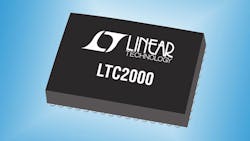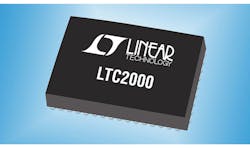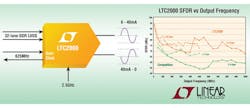This file type includes high resolution graphics and schematics when applicable.
Precise signal generation often starts with an oscillator. In the case of the LTC2000 digital-to-analog converter (DAC) from Linear Technology, however, it can start in the digital realm with little or no compromise in spectral purity and other critical signal characteristics.
This high-performance DAC achieves -74 dBc spurious-free dynamic range (SFDR) at 200 MHz by means of its 16-b resolution and 2.5-GSamples/s sampling rate; it delivers instantaneous output bandwidths as wide as 1 GHz for a wide range of applications, from communications systems to test-and-measurement gear. The SFDR across the full 1-GHz output range is a still-impressive -68 dBc.
The LTC2000 DAC (Fig. 1) is available in a number of different versions—with 11, 14, or 16-b resolution—each supplied in a 170-lead, RoHS-compliant, BGA package measuring 9 ×15 × 1.54 mm. The parallel data input ports support low-voltage-differential-signaling (LVDS) and differential-high-speed-transceiver-logic (DHSTL) input data signals, with data input clocks working to 625 MHz and data rates to 1.25 Gb/s using a double data rate (DDR) scheme (Fig. 2). The data input clock can be in quadrature or in phase with the data arriving at the input ports.
Each DAC version has two input ports, and the DACs can be operated in single- or dual-port modes. In single-port mode, one of the input ports is grounded and the DAC operates at sampling rates to 1.25 GSamples/s. In dual-port mode, data is written to both ports simultaneously and then interleaved inside the DAC, enabling operation at sampling rates to 2.5 GSamples/s.
The LTC2000 DACs are available in commercial and industrial versions for operating temperatures from 0 to +70° (model LTC2000C) and -40 to +85°C (model LTC2000I), respectively. The DACs offer ±1-V compliant outputs with 40-mA full-scale current which can be adjusted to as low as 10 mA and as high as 60 mA. Running the DACs faster consumes a bit more power, but offers impressive performance levels for output signals to 1 GHz.
The single-sideband (SSB) phase noise, for example, at 2.5 GSamples/s, is -147 dBc/Hz at an offset of 10 kHz from a 65-MHz carrier and a mere -165 dBc/Hz at an offset of 1 MHz from the same carrier. The spurious-free dynamic range (SFDR) for a sampling rate of 1.25 GSamples/s in single-port mode is -82 dBc for an output frequency of 100 MHz, -74 dBc for an output of 250 MHz, and -74 dBc for an output of 500 MHz. For a sampling rate of 2.50 GSamples/s in dual-port mode the SFDR is -76 dBc for an output frequency of 100 MHz, -72 dBc for an output of 500 MHz, and -68 dBc for an output of 1000 MHz.
The two-tone intermodulation distortion (IMD) for these DACs is also minimal. For a sampling rate of 1.25 GSamples/s, the two-tone IMD is -100 dBc at 50 MHz, -90 dBc at 250 MHz, and -82 dBc at 500 MHz. For a sampling rate of 2.50 GSamples/s, the two-tone IMD is -87 dBc at 100 MHz, -84 dBc at 500 MHz, and -78 dBc at 1000 MHz.
These DACs are well suited for generating wide-bandwidth, high-frequency signals for wired and wireless communications systems, radar and other defense systems, and in test equipment. They are capable of generating signals with minimal delays from applied input data. At 2.5 GSamples/s, the DACs consume 2.2 W from dual +1.8- and +3.3-VDC supplies, dropping the power consumption to just 1.3 W at 1.25 GSamples/s.
Linear Technology Corp., 1630 McCarthy Blvd., Milpitas, CA 95035-7417; (408) 432-1900, FAX: (408) 434-0507
This file type includes high resolution graphics and schematics when applicable.
About the Author
Jack Browne
Technical Contributor
Jack Browne, Technical Contributor, has worked in technical publishing for over 30 years. He managed the content and production of three technical journals while at the American Institute of Physics, including Medical Physics and the Journal of Vacuum Science & Technology. He has been a Publisher and Editor for Penton Media, started the firm’s Wireless Symposium & Exhibition trade show in 1993, and currently serves as Technical Contributor for that company's Microwaves & RF magazine. Browne, who holds a BS in Mathematics from City College of New York and BA degrees in English and Philosophy from Fordham University, is a member of the IEEE.



